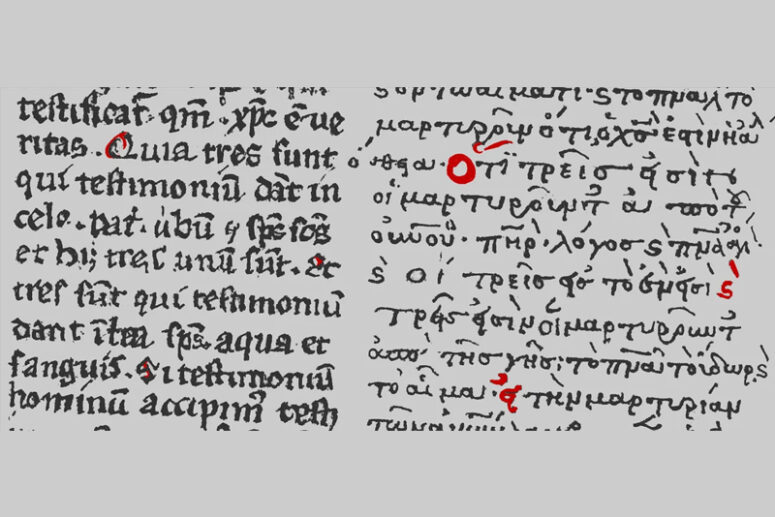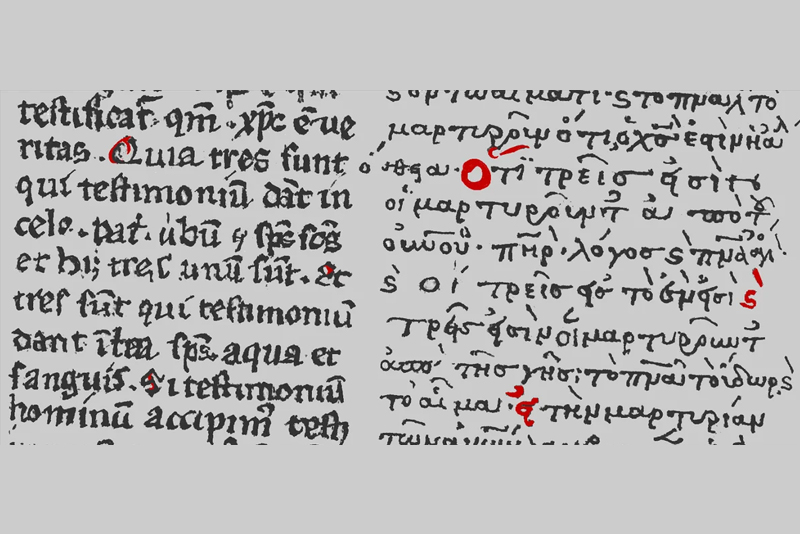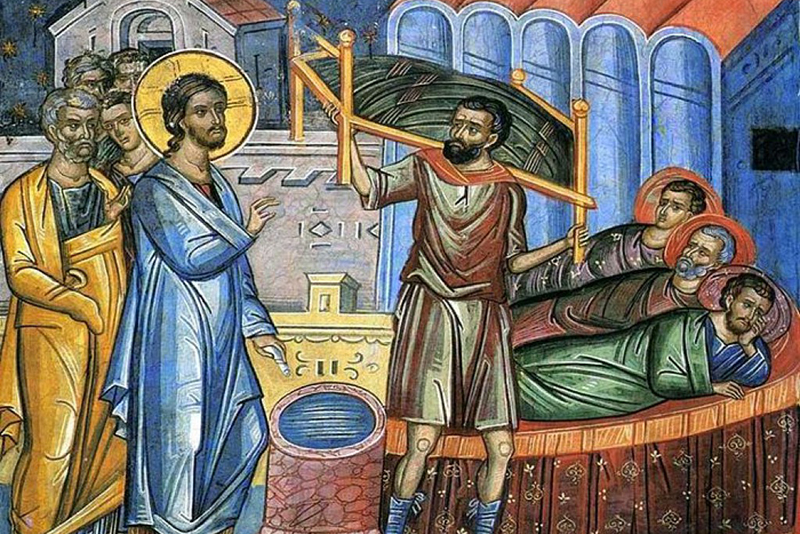
Returning to the topic of the authenticity of 1 John 5:7, let me address it in greater detail and balanced, in light of the current state of research.
The verse in question reads, “For there are three that bear witness in heaven: the Father, the Word, and the Holy Spirit; and these three are one.” (1 John 5: 7).

Scholars refer to this verse as the Johannine Comma (“Comma Johanneum”). In the West, it is considered by most as a late addition to the biblical text. The proponents of this view cite the absence of the fragment from most Greek and old oriental translations of the Scripture, and the lack of references to the passage from the Greek fathers of the church.
Some scholars, however, defend the authenticity of the Comma. The debate has been ongoing for many centuries, so let me start by reviewing some of the principal arguments on both sides.
Firstly, the passage has been notably present in the Latin tradition since early times. It is found in most manuscripts of the old Italic translations, and the Vulgate.
The Holy Martyr Cyprian of Carthage cited it in his third-century book “On the Unity of the Church”: “Again, it is written of the Father, Son and the Holy Spirit that all three are one. The opponents of the Comma’s authenticity see it as an allegorical interpretation of 1 John 5:8: “For there are three that testify: the Spirit, the water and the blood; and the three are in agreement.”
Yet defenders of the Comma are unconvinced. They believe that if it were an allegorical interpretation, it would not be self-evident and commonly accepted to be cited without comment or explanation. Yet, nowhere in his writings does Saint Cyprian refer to an allegorical understanding of Verse 8. No Latin author of the second or third century cited the fragment. The first citations of Western authors do not appear until much later, in the fifth and sixth centuries.
Without these textual problems, no scholar would have had grounds to dispute the fact that the citation in the work of Saint Cyprian was of the Comma. Furthermore, the earliest surviving Greek manuscripts with the Comma date back to the fourth century. If Saint Cyprian was referring to the authentic text of the Comma, the witnesses of the presence of the Comma must have preceded the witnesses of its absence. The defenders of the Comma make exactly this argument, saying that Saint Cyprian lived a hundred years before the date of the oldest surviving manuscript containing the verse in question.
In turn, the deniers of the Comma prefer to ignore the above-mentioned reference from Saint Cyprian. The subsequent Latin traditions abound in the references to 1 John 5:7. The verse is quoted verbatim by Priscillian, in the treatises De Trinitate», «Contra Varimadum» и «Speculum “Audi Israhel”, and in multiple works by Fabius Fulgentius, Cassiodorus, Isidor of Seville, Bede the Venerable, and multiple other authors.
The use of this verse by the fathers of the Council of Carthage of 485 and in the Prologue to the Canonical Epistles are noteworthy in this regard. The latter work, attributed to Saint Jerome of Stridon, is widely believed to have been written by another author from the fifth century, possibly by the Venerable Vincent of Lérins.
Admittedly, the Comma is absent from several ancient Latin manuscripts of the Scripture. The author of the Prologue explains this fact as follows, “We concluded that in this passage the neglectful translators had digressed from the truth by leaving in their texts only three words – air, blood and spirit, while omitting the mention of the Father, Word and the Spirit, despite its great significance in supporting the tenets of the catholic faith.”
As follows from the citation, Saint Jerome Stridon, or an alternative author of the work considered the verse to be a part of the original text of the Scripture omitted by some of the copiers; he must also have believed that the verse was present in the Greek manuscripts. This view is being upheld by the modern defenders of the Comma.
They point to the limited amount of surviving textual evidence – today, there are only fourteen known Greek manuscripts dating back to the period between the appearance of the epistle of John and the tenth century. They also cite multiple references of 16th and 17th-century authors to other Greek manuscripts with the Comma that have not survived or have not been located. The number of such references is growing, from eight – named by Mezger at the end of the 10th century, to as many as eleven today.
Second, the defenders of the Comma challenge the “argument from silence” of the ancient authors. They suggest that the church scholars of the time were often inexact in their citations from the Scripture, as in many cases they were quoting from memory, not from the text and used allusions instead of direct quotes. They cite examples of such numerous allusions to the verse in Tertullian, Origen, Bishop Athanasius, Augustine Aurelius and multiple other writers. Opponents dismiss them as allegorical interpretations of 1 John 5:8 or as simple coincidences. Yet this argument seems to discount as allusions the references to the Comma, but not to the other fragments of the scripture, and therefore appears biased.
Thirdly, defenders of the Comma point to its citations in the writings of Jacob of Edessa, a 7th-century Syrian author, Gregory of Sisa, from 13th-century Armenia and in the documents of the Sisa Council of the Armenian Church in 1307. They present them as proof of the Comma’s presence in the Greek manuscripts of the time that must have been the sources of the citation. Their opponents insist that the authors of these texts were quoting from the Latin manuscripts, as did the late Byzantine writers from the 14th and 15th centuries – Manuel the Cripple, Joseph Bryennios and Gennadius Scholarius.
Fourthly, the defenders of the Comma looked for evidence of their authenticity in a syntactic, structural and contextual analysis of the biblical verses, but their opponents rejected their arguments. In a nutshell, while arguments from the grammar and style cannot provide sufficient proof of the presence of the Comma verse in the original biblical text, proponents of the Comma have still been able to show that the verse fitted into the biblical text neatly and naturally.
The proponents of the Comma do not deny its absence from many ancient manuscripts until the fourth century or that many ancient authors were not aware of it. Yet the big question is: if the comma passage was a part of the original text, why did it disappear?
Some attributed the disappearance to the work of the Arians. Indeed, the Arians had every reason to dislike the passage. Moreover, they were in control in many episcopates of the Eastern Church. Some church writers of the time (e.g. Ambrosias Mediolanensis or Socrates Scholasticus) directly accused them of interfering with the text of the biblical passages that they did not like. But why were many scholars opposed to the Arians also unaware of the Comma, and why is it absent from many Latin copies, even though the Arians were much weaker in the West? The omission must have happened earlier than that; therefore, most proponents of the Comma date it to the third century, the time of the Sabellian controversy. [16] This would have provided a plausible explanation, if not for the lack of any reliable evidence of purposeful and systematic changes to the biblical text introduced throughout the Church.
Finally, it was proposed that the verse might have been omitted not by some evil design, but by mistake; the original copier might have missed the seventh verse because of its similarity in content with the eighth. Similar mistakes had happened before and received the name Homeoteleuton. [17] For this version to be plausible, the error must have happened early enough to have an impact on all of the Greek copies of the first epistle of John.
Noteworthy in this regard is the view of Walter Tille, an expert in the old Latin translations of the New Testament. To him, it is beyond dispute that Saint Cyprian was quoting the text of the Scripture that was known to him. In the text “De Centesima, Sexagesima, Tricesima” many scholars also see the fragment about the Father, Son and the Spirit as three ‘witnesses” as an allusion (or a direct quote) of the Comma. The text is also signed with the name of Saint Cyprian but is believed to have been written by another author. Some date it to the second century, some suggest that is a third-century rewrite of a second-century sermon.
Tille placed the Comma fragment in the context of the other known additions characteristic of the old Latin biblical translations. He traces them to an extended version of the Greek text that served as the original of the second century Italic translation and subsequently for the abridged version of the Greek text with the omission of the Comma and several other fragments.
It is plausible that the Apostle John or some of his disciples may have produced an extra extended version of the first epistle that ended up in the West and became the original for the Italic translation used by Saint Cyprian and several North African and Spanish authors. Meanwhile, in the East, an earlier and shorter version of the epistle was proliferating.
The existing evidence is insufficient to prove this version with full certainty but is fully adequate to consider it plausible. So far, we have considered the historical evidence from a purely academic perspective.
However, as we view the matter from the perspective of the Christian tradition, we should remember that the biblical Canon the way we know it now was first approved at one of the Councils of Carthage at the end of the fifth century. The fathers of this Council treated the Comma as a part of the Holy Scripture. If we trust the judgement of these holy fathers on which books to consider the true word of God, we must also accept their view on which verses of the first epistle of John to accept as the original text.
Translated by The Catalogue of Good Deeds
Source: https://zen.yandex.ru/media/id/5f3fffbac8ce966b514f9e15/esce-raz-o-probleme-1in-57-608ce1024e93064eb8fcfbcf




